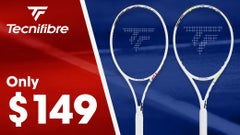Selecting the Right Racquet
by Tennis Warehouse
If you’re like most Tennis Warehouse customers, you already have an idea of the type of racquet you’re seeking. You want to upgrade from your current racquet - maybe you’re seeking more power, more control, more comfort... or a little of all three. Whatever your reason(s) for purchasing a new racquet, you have some basis on which to make your decision.
Then again, you may not have a clue as to which racquet is best for you and are simply motivated by a review you read. Add to the confusion the shear amount of racquets available and choosing the right racquet becomes pretty daunting! To make this process a little easier, here’s a primer on racquet characteristics and how they affect performance. We also suggest you read our racquet reviews where you’ll find detailed information from real tennis players on how a specific racquet performs on-court. Our Racquet Technologies section includes explanations and illustrations of racquet technologies and materials, such as nCode, Hot Melt, Liquidmetal, and F.I.R.E., to name a few. Finally, our General Racquet & String Terms provide definitions of terms that are used throughout our website to describe racquet and string performance.
Today, there are 3 major racquet categories, with several subcategories. They are:
Category 1: Power or Game Improvement Racquets
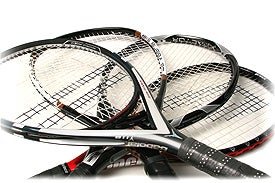
Category 2: ‘Tweener Racquets
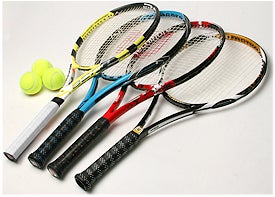
Category 3: Control or Player’s Racquets
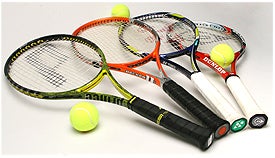
When making a racquet choice, you will need to consider the following features:
Head Size
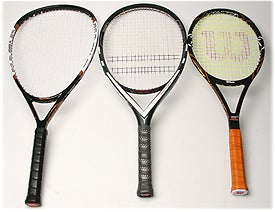
Power is directly related to head size - a larger head will provide more power than a smaller head, all other things being equal. A larger head also offers a larger hitting area and sweetspot, providing more forgiveness on off-center hits. Today’s racquets are offered in head sizes ranging from 85 to 135 square inches, with the most common being 95-110. These head sizes offer a compromise between power and control for many players. Generally speaking, a smaller racquet head appeals to more accomplished players seeking more control, while larger racquets appeal to beginning and intermediate players seeking more power and a larger sweetspot.
Length
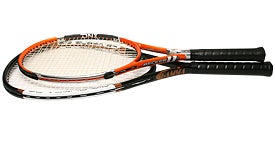
Racquets are available in lengths ranging from 27-29 inches, the legal limit for tournament play. Standard racquets are 27 inches long. A longer racquet provides more reach on groundstrokes, added leverage on serves and slightly more power overall than standard length racquets, all other things being equal. For most players, switching from a standard length racquet to one that is 1/2 -1 inch longer doesn’t normally present much of a problem. Most (but not all) longer racquets are lighter than their standard-length counterparts to keep them maneuverable. As racquet length increases, so does dynamic swingweight. Simply lengthening a 27 inch racquet without reducing weight would result in a very unwieldy “club”.
Weight & Balance

These two characteristics most influence how a racquet feels when you pick it up and when you swing it on the tennis court. Some basic concepts - a heavy racquet is more powerful, more stable and transmits less shock than a lighter racquet (all other things being equal). A lighter racquet is more maneuverable and thus, a player is able to swing it faster. If this is true, won’t a lighter racquet that is swung fast generate the same power as a heavier racquet that’s swung more slowly? This question has been hotly debated ever since Wilson introduced their Hammer racquets back in 1990. Until then, racquet weights averaged 12-13 ounces and were balanced head light (or handle heavy). Wilson’s Hammer “technology” reduced overall racquet weight (10-11 ounces) but distributed more mass in the head, resulting in a head-heavy balance. The idea was to improve maneuverability without sacrificing power by keeping weight in the racquet’s hitting zone. Since then, racquet weights have steadily dropped and now we have sub-10 ounce offerings from most manufacturers. Is lighter better? Not necessarily. Well then, which racquet weight is best for you? What about racquet balance? Is head-light, head-heavy or even balance best? In order to answer this question, you need a point of reference. How heavy is your current racquet? Is it head light or head-heavy? How much? If you don’t know, you can e-mail us at info@tennis-warehouse.com and we’ll send you the manufacturer’s specifications, if available.
Next, do you want a lighter, heavier or similarly weighted racquet? Head-light, head-heavy or evenly balanced? Chances are you don’t know what you want until you play with a racquet. If this isn’t feasible, here are some guidelines on the advantages and disadvantages of different weights and balances.
Heavier, head-light racquets- preferred by most professional players, these racquets are often referred to as being “traditionally weighted and balanced” racquets. They typically weigh 11-13 ounces and are balanced 1/2 to 1-1/2 inches head light in order to retain maneuverability. In most cases, these racquets are also referred to as “player’s” racquets because they are generally more control-oriented and designed for players who provide their own power.
Lightweight, head-heavy racquets - several years ago, Wilson discovered it was possible to make a racquet more maneuverable without reducing weight in the head. By removing weight in the handle, the racquet was lighter overall, while still retaining mass in the upper hoop, where ball contact occurs. This was the concept behind their Hammer and Sledge Hammer designs. Several other racquet manufacturers have subsequently introduced lightweight, head-heavy (and evenly balanced) racquets. The advantages of this racquet type are increased maneuverability without sacrificing power, especially on groundstrokes. The disadvantages are less clear - some “experts” argue that reducing weight increases the amount of shock transferred to the wrist, elbow and shoulder. Some players who have switched from traditionally weighted and balanced racquets to lightweight, head-heavy models claim the racquets don’t feel “solid”. Clearly, you can’t get something for nothing. Reducing racquet weight will alter its feel - for better or for worse. Keep in mind, you can always add weight to a racquet if it’s too light. Reducing racquet weight, however, is almost impossible.
Frame Stiffness
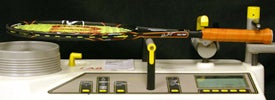
The amount a frame deflects during ball contact directly affects its power potential. A stiffer racquet bends less, thus depleting less energy from the ball. A flexible racquet bends more, resulting in more energy loss. A common myth among players is that a flexible racquet, that bends back more, returns more power to the ball due to a catapult-effect. The ball remains on the strings for 3-5 milliseconds, much shorter than it takes a frame to recover. Consequently, a racquet frame doesn’t “return” energy to the ball, it absorbs energy - either more or less, depending on stiffness. Stiffer racquets don’t deflect as much on impact, resulting in less power drain than a flexible racquet.
Frame stiffness doesn’t only affect power though. Control and comfort are also at stake. Generally speaking, a racquet that offers more power provides less control. However, this is largely dependent on player type and ability. An advanced player may prefer a flexible racquet because he or she has a long, fast swing and provides plenty of power. A stiff racquet might be too powerful for this player, resulting in too many balls landing long. A beginning or intermediate player though, may find a stiffer racquet that doesn’t deflect as much on impact, provides better control. This may also apply to a more advanced player with short, compact strokes. To a certain point, stiffer racquets are generally less comfortable than more flexible racquets. A very stiff frame will transmit more impact shock to the wrist, elbow and shoulder than a medium stiff frame. Comfort is difficult to measure - each player has a different perception of what feels comfortable. However, players with arm and/or shoulder problems will generally benefit more from a flexible to medium-stiff frame and should likely avoid stiff or very stiff frames. A lesser known effect of frame stiffness is the amount of spin that can be generated. Generally speaking, stiffer racquets provide less spin than flexible racquets because the ball leaves the stringbed more quickly.
String Pattern
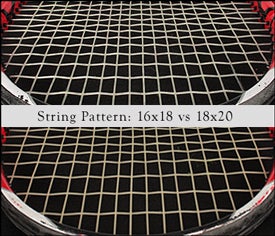
Often overlooked by many recreational players, string pattern density influences many aspects of a racquet’s overall performance and feel. When we discuss string pattern density, we refer to open and dense (or closed).
An open string pattern will deflect more on impact than a denser pattern, providing greater ball rebound. Strung at the same tension (in similar racquets) an open string pattern won’t feel as “tight” as a dense string pattern. Open string patterns also allow for more spin potential, as the ball can embed itself into the strings more, due to their wider spacing. Players seeking more spin will benefit from a more open string pattern. The price one may pay for this, though, is reduced string durability. Open string patterns allow the strings to move more freely, increasing abrasion which causes string breakage.
A denser string pattern won’t deflect as much upon ball impact, resulting in less rebound energy. More closely spaced strings will also offer less spin potential but will last longer than a similar racquet featuring a more open string pattern. Players who don’t hit with much spin and are seeking enhanced control will generally prefer racquets with denser string patterns, as will hard-hitting topspin players seeking increased string durability.
Grip/Handle Systems
As racquets become lighter and lighter, manufacturers are seeking ways to improve comfort without significantly increasing weight. Incorporating a shock and vibration dampening system in the handle is the most common method currently being used. Dunlop’s ISIS, Head’s No SHOX, Prince’s Air and Volkl's’s Sensor handle systems offer varying degrees of effectiveness in reducing frame shock and vibration. Wilson and Yonex also offer comfort systems located in the racquet shaft such as Iso-Zorb and V-Con technologies.
 |
 |
 |
 |
 |



